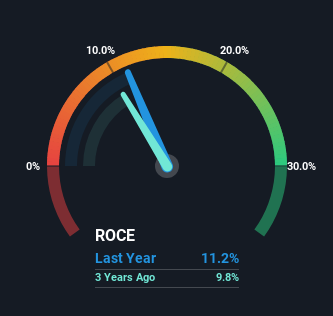- Switzerland
- /
- Telecom Services and Carriers
- /
- SWX:SCMN
Swisscom (VTX:SCMN) Has More To Do To Multiply In Value Going Forward
If you're not sure where to start when looking for the next multi-bagger, there are a few key trends you should keep an eye out for. One common approach is to try and find a company with returns on capital employed (ROCE) that are increasing, in conjunction with a growing amount of capital employed. If you see this, it typically means it's a company with a great business model and plenty of profitable reinvestment opportunities. However, after investigating Swisscom (VTX:SCMN), we don't think it's current trends fit the mold of a multi-bagger.
What Is Return On Capital Employed (ROCE)?
For those that aren't sure what ROCE is, it measures the amount of pre-tax profits a company can generate from the capital employed in its business. To calculate this metric for Swisscom, this is the formula:
Return on Capital Employed = Earnings Before Interest and Tax (EBIT) ÷ (Total Assets - Current Liabilities)
0.11 = CHF2.3b ÷ (CHF25b - CHF4.3b) (Based on the trailing twelve months to December 2023).
Therefore, Swisscom has an ROCE of 11%. In absolute terms, that's a satisfactory return, but compared to the Telecom industry average of 8.9% it's much better.
View our latest analysis for Swisscom

Above you can see how the current ROCE for Swisscom compares to its prior returns on capital, but there's only so much you can tell from the past. If you'd like, you can check out the forecasts from the analysts covering Swisscom for free.
So How Is Swisscom's ROCE Trending?
Things have been pretty stable at Swisscom, with its capital employed and returns on that capital staying somewhat the same for the last five years. It's not uncommon to see this when looking at a mature and stable business that isn't re-investing its earnings because it has likely passed that phase of the business cycle. So don't be surprised if Swisscom doesn't end up being a multi-bagger in a few years time. On top of that you'll notice that Swisscom has been paying out a large portion (69%) of earnings in the form of dividends to shareholders. If the company is in fact lacking growth opportunities, that's one of the viable alternatives for the money.
The Bottom Line On Swisscom's ROCE
In a nutshell, Swisscom has been trudging along with the same returns from the same amount of capital over the last five years. Unsurprisingly, the stock has only gained 33% over the last five years, which potentially indicates that investors are accounting for this going forward. Therefore, if you're looking for a multi-bagger, we'd propose looking at other options.
One more thing, we've spotted 1 warning sign facing Swisscom that you might find interesting.
While Swisscom isn't earning the highest return, check out this free list of companies that are earning high returns on equity with solid balance sheets.
New: Manage All Your Stock Portfolios in One Place
We've created the ultimate portfolio companion for stock investors, and it's free.
• Connect an unlimited number of Portfolios and see your total in one currency
• Be alerted to new Warning Signs or Risks via email or mobile
• Track the Fair Value of your stocks
Have feedback on this article? Concerned about the content? Get in touch with us directly. Alternatively, email editorial-team (at) simplywallst.com.
This article by Simply Wall St is general in nature. We provide commentary based on historical data and analyst forecasts only using an unbiased methodology and our articles are not intended to be financial advice. It does not constitute a recommendation to buy or sell any stock, and does not take account of your objectives, or your financial situation. We aim to bring you long-term focused analysis driven by fundamental data. Note that our analysis may not factor in the latest price-sensitive company announcements or qualitative material. Simply Wall St has no position in any stocks mentioned.
About SWX:SCMN
Swisscom
Provides telecommunication services primarily in Switzerland, Italy, and internationally.
Average dividend payer and slightly overvalued.
Similar Companies
Market Insights
Community Narratives





